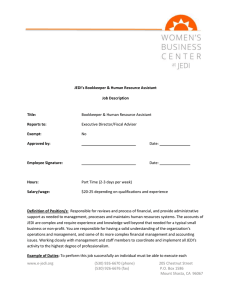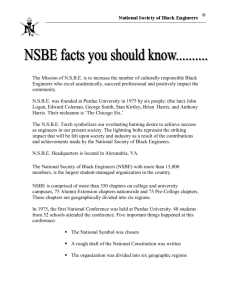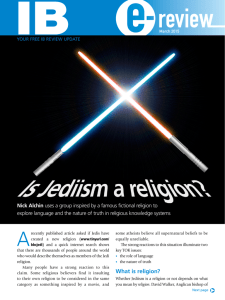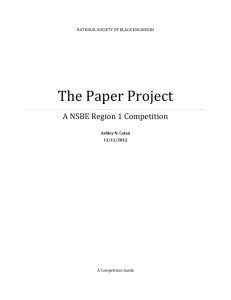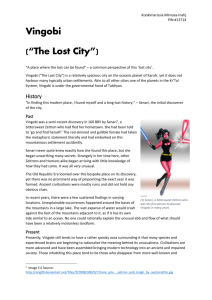Space SIG 101 Overview
advertisement
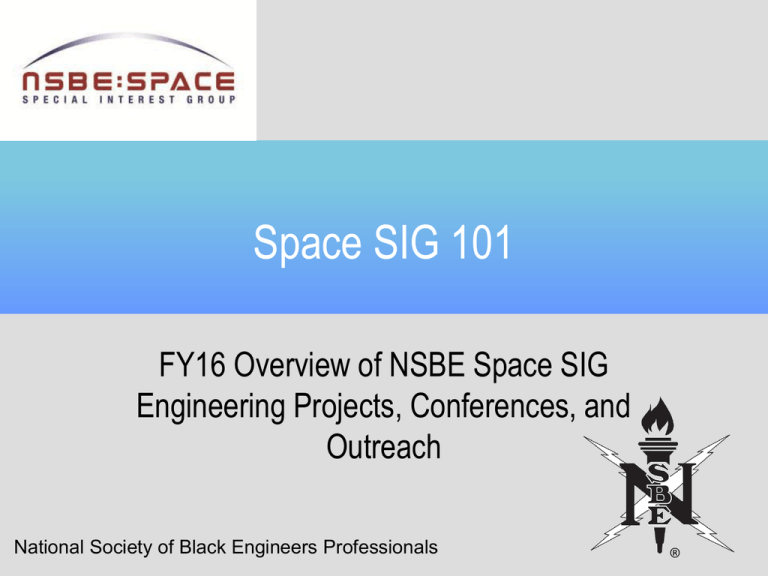
Space SIG 101 FY16 Overview of NSBE Space SIG Engineering Projects, Conferences, and Outreach National Society of Black Engineers Professionals What Does it Mean to be 501(c)3 according to IRS? • The exempt purposes set forth in section 501(c)(3) are charitable, religious, educational, scientific, literary, testing for public safety, fostering national or international amateur sports competition, and preventing cruelty to children or animals. The term charitable is used in its generally accepted legal sense and includes relief of the poor, the distressed, or the underprivileged; advancement of religion; advancement of education or science; erecting or maintaining public buildings, monuments, or works; lessening the burdens of government; lessening neighborhood tensions; eliminating prejudice and discrimination; defending human and civil rights secured by law; and combating community deterioration and juvenile delinquency • Source: http://www.irs.gov/charities/charitable/article/0,,id=175418,00.html Red text = areas of intersection with the Space SIG NSBE Mission • Mission – To increase the number of culturally responsible Black engineers who excel academically, succeed professionally, and positively impact the community • Organization NEB PEB Programs Zone Space SIG NSBE Professionals • NSBE Professionals Vision – To be the premier career access organization for Black technical professionals – To develop and impact active NSBE professional members to succeed as future corporate leaders, technical experts in industry, and strong stewards in their communities • NSBE Professionals Focus Areas – Increase membership value – Increase NSBE Professionals programs participation – Develop NSBE Professionals Chapters Space SIG • The mission of NSBE Space is to stimulate the active participation of the community, with focus on the Black community, both within and beyond the engineering profession, in space-related activity • The purpose of NSBE Space is to enable NSBE Professionals to serve as a bridge between NASA and the community, with focus on the Black community in an inspirational and educational capacity; to encourage the realization of the “One-NASA” vision within NASA centers; and to apply the technical expertise of its members to develop solutions to enhance the public and private space capabilities of the United States Space SIG • Space SIG success requires the leadership of many people – Technical Leadership • Subject matter expertise – Managerial Leadership • Organizational excellence, influence leadership, political savvy – Operational Leadership • Financial, marketing, communications expertise • Any activity/initiative lacking above leadership is at risk Member Engagement • Goal: every member of the Space SIG to be engaged in some capacity • Over 250 available roles for NSBE Professionals to choose from – – – – – Space SIG Board of Directors (10) Admin Support Volunteers (10) Conference Planning Teams (65) Technical Project Teams (160, with room for growth) Outreach Project Team (10) 2-5 Commitment Strategy • What level of involvement are we asking for from current and potential members? – Participate in ONE role • Project Team, Conference Planning, Outreach Team, or Board – Average of 2-5 volunteer hours per week • 0-2 hours: meetings • 0-2 hours: project work • 1 hour: communication – 10-15 min per day – Tell someone about NSBE, help them join, update your NSBE group lead on accomplishments NSBE Space SIG Engineering Projects (Most projects divide into subprojects) • Arusha – Long range pressurized rover design • East Africa Spaceport – Feasibility study • Macho Mengi – Cubesat-based multi-telescope constellation using interferometry • Space Robotics – Robotic system technology development • Power Beaming – Wireless energy transfer study • Visions for Human Space Flight Working Group – White paper recommendation Chapter Project Engagement • Space SIG projects are open to chapter participation • NSBE Professionals chapters can host portions of a project to conduct as a chapter program – Provides programmatic content to program – Provides manpower to Space SIG – Enables appropriate NSBE expertise to be directed to each project • This idea at full maturity: the Space SIG leads a coalition of dozens+ Professionals chapters to build an operational spacecraft, which is then launched via a NSBE aerospace corporate or government partner Project Arusha Research to Inform Human Space Exploration In 1969, America stepped foot on the Moon. In 1972, America left. Will anybody ever return? Why? What should a return achieve? How Do We Go From Outposts… To Colonies? Project Arusha Overview • Arusha is Swahili for “He makes fly (into the skies)” • Conceptual design project of NSBE Space SIG – Commercial/international lunar expansion beyond an initial return to the Moon (next step after Cx/FLO/etc.) – 48 people living and working on the Moon • Staggered 2-year crew rotations – Rover transportation required between a primary base at the South Pole and additional facilities across Moon • Six person crew, lunar circumnavigation capability • 30-day rover excursion mission duration Project Arusha Overview Rover Workstations and Subsystems Arusha Long Range Rover Transportation Between Facilities Arusha Lunar Architecture South Pole Base, Multiple Surface Facilities Project Arusha Rover • Arusha Rover Cabin – Current research focused on cabin – Pressure vessel 3m diameter, approximately 8.5 m length barrel – Additional logistics module provides stowage space but cabin is sole pressure vessel for habitation Arusha Rover Extensibility to NASA Exploration • NASA and Commercial use of ~3m diameter spacecraft – Atlas propellant tank and Cygnus cargo freighter are both 3m diameter – Select Mars Phobos and Surface habitat concepts use 3m diameter modules – A workstation that can be packaged inside the Arusha rover can also be packaged inside a commercial-derived spacecraft or Mars habitats – Arusha-type rover on Mars greatly expands Mars exploration range Arusha FY15 Focus Areas • Deployable Maintenance Workstation (Hosted at Houston Space Chapter) • Deployable Medical Workstation (Hosted at Houston Space Chapter) • GNC Subsystem • Power Subsystem • Cabin Structure Subsystem • Crew Exercise Capability (August kickoff) Arusha Future Focus Areas • • • • • • • • Deployable Sleep Stations Cockpit Workstations Flight Crew Equipment Hygiene Facilities External Logistics Module Interior / Exterior Lighting Communications Subsystem Data Subsystem Projects can be initiated upon evidence of sufficient membership interest and technical expertise • Robotic Manipulators • EVA / Suit Port Subsystem • Inflatable Docking Tunnel / Emergency Airlock • ECLSS and Thermal Subsystems • Mobility Subsystem • Full Scale Medium Fidelity Cabin Mockup Arusha Projects • Rover Subsystems – GNC Subsystem • Conduct a preliminary design for the rover GNC subsystem • Consider implications of lunar canyons, deep craters, and lava tubes • Develop protocols for operations when the rover is beyond line of sight of any orbital or surface communications relays Arusha Projects • Rover Subsystems – Power Subsystem • Create design to supply average 260-300 kW with 30-day continuous operation • Trade nuclear fission vs. regenerative fuel cell solutions – Cabin Structures • Define cabin pressure shell, including hatches, windows, and suit ports • Define interior and exterior structural load attach points • Trade composite versus metallic pressure shell construction Arusha Projects • Deployable Crew Workstations – Maintenance Workstation • Develop facility capable of repairing critical failures during excursions – Medical Workstation • Develop medical care facility for crew injuries or illnesses – Crew Exercise Capability • Aerobic and resistive exercise equipment and protocols Arusha Progress • Deployable Maintenance Workstation – Completed first round of study fall 2013 – Paper presented at 2014 Aerospace Systems Conference – Workstation concept presented to NASA Advanced Exploration Systems’ Exploration Augmentation Module Project Manager Lora Bailey • Exploration Augmentation Module project interested in both medical and maintenance concepts from Arusha Arusha Progress • Suit Port Maintenance Glovebox – Component of deployable maintenance workstation – Enables repair of “dirty” or toxic exterior rover components without bringing component inside cabin • Ammonia pumps, wheel mechanisms, etc. – Low fidelity glovebox mockup tested fall 2014 on NASA lunar rover (MMSEV Cabin 1B) – Progress update presented at December 2014 NASA Human Factors TDT meeting – Medium fidelity mockup fabrication to be completed by end of year 2015 Arusha Funding • NASA Human Factors Technical Discipline Team provided funding to purchase hardware for fabrication of medium fidelity mockups – Maintenance Workstation • • • • Stowage shelving Deployable desk Suit port maintenance glove box Dust mitigation shrouds – Medical Workstation • Stowage shelving • Deployable table • Surgical table surface • Substantial additional funding needed to build full scale cabin structure (no less than ~$50K+) • Pursuing collaborative partnerships at NASA Johnson Space Center and Marshall Space Flight Center East Africa Spaceport Feasibility Study East Africa Spaceport Overview • Project intent: Investigate the feasibility of a spaceport in the East African Community (EAC) that could provide low cost, reliable access to space while stimulating African economic and technology advancement – Determine strategic US interests served by an equatorial African spaceport – Determine benefit to African countries from EAC spaceport East Africa ASC Developments • Interest identified from multiple East African government officials • Potential interest in hosting an Africa Space Development Forum at 2016 Aerospace Systems Conference • Might not focus exclusively on East Africa – Other nations may contribute space activity that builds the case for a spaceport in East Africa • DC location hoped to increase potential access to Congressional offices and State Department Macho Mengi Innovative Approaches for Astronomical Observation Macho Mengi Project • Swahili for “many eyes” • Observatory system involving numerous groundbased and space telescopes that can combine their total functionality to act as a large observatory • Long range goals (technical feasibility TBD) – Ability to use system to detect potentially hazardous asteroids in the solar system or planets orbiting other stars – NSBE telescope network available to HBCUs, K-12, other academic and research institutions Macho Mengi Partnerships • Former partnership with NASA Ames – Cubesat deployable/inflatable telescope feasibility study 1. • Current partnerships 2. – Draper Labs, Texas A&M, GeoControls, Seal of Valor, C3 Software Macho Mengi Interferometry • Current focus is study of various techniques to combine images from multiple light sources • Optics educational tool provided initial learning – Currently pursuing marketing of tool to Lego – Also assembling Michelson interferometer with opticalgrade components – Next step: imaging interferometer – Will be first testbed capable of processing actual imagery Space Robotics Space Robotics Engineering RFI Response • Responded to NASA Centennial Challenges Program Space Robotics Challenge Request for Information – NASA requests information prior to releasing call for proposals in order to consider relevant information from subject matter experts – Challenge involves software development for NASA R5 robot (Valkyrie) • Expressed interest in submitting proposal for challenge when released RFI Response • Recommended challenge include representative tasks for International Space Station maintenance and human robotic interaction • Recommended specific scoring metrics to include in competition • Recommended challenge time assess ability of robot to perform tasks in the same or less time an astronaut requires Power Beaming Demonstration Unit Wireless Energy Transfer Study Power Beaming Demonstration Unit • Develop and characterize demonstrations of wireless energy transfer of increasing scale – Definition: Transfer of electrical energy from source to user without connecting wires (no transmission lines) • Technology pathfinder as precursor to investigations of feasibility of wireless energy transfer between celestial objects – Paper studies have advocated power beaming since the 1970s, but little engineering has been done to understand losses or other limitations Power Beaming Demonstration Unit • NSBE unit assembled spring 2011 and demonstrated at National Convention • Transmits 1 watt across 18-24 inch distance • Illuminates LED light bank • Replicates 2008 Moon Society demonstration Power Transmission System Power Supply (120V to 12V) 1U Signal Generator (2.6 GHz) Power Reception System Microwave Amplifier (1 Watt) Microwave Panel Antenna Microwave 2.6 GigaHz to Panel 12V DC Rectifier Antenna Powered Device (LEDs) Power Beaming Demonstration Unit • Expertise and hardware to analyze unit exists at NASA Goddard Space Flight Center • Asking Greenbelt Space Chapter to host project • Unit assigned to Myron Fendall and Mark Branch at Goddard • FY15 goal to add 3-5 Greenbelt Space NSBE members to project team and support project as a Greenbelt Space Program Visions for Human Space Flight Working Group Reconciling competing visions for humans in space and promoting coherent US space policy Visions for Human Space Flight Working Group • Space SIG conducted one-year study of options for US human space flight and driving rationales of key stakeholders • Task: explore conflicting visions for human space flight and recommend architecture with rationales • Identified acquisition costs as a major national issue affecting entire nation, not just NASA – Dramatic acquisitions cost growth since WWII • F-35c fighter costs 152 times more than WWII era P-51 fighter after adjusting unit costs of both aircraft to FY2012 dollars Visions for Human Space Flight Working Group • Applied X-38 acquisition model to apply at major program level with multi-destination spacecraft elements • Results compiled into Unlimited Horizons – a white paper detailing NSBE recommendations for US human space flight – Low cost approach to asteroid, lunar, and Mars missions – Mixed NASA, commercial, international teaming • Feeds into annual legislative visits via Space Exploration Alliance (nonprofit coalition) Visions for Human Space Flight Feedback • Unlimited Horizons Brown Bag Series – Informal monthly discussions held fall 2014 at Johnson Space Center – JSC community provided feedback on NSBE recommendations • Informal and formally documented comments – Each month July-December covered different section of white paper Visions for Human Space Flight Next Steps • NASA reviews indicated need for additional Systems Engineering products to accompany white paper – Work Breakdown Structure – Product Breakdown Structure – Responsibility Assignment Matrix (RACI) • Currently inactive – Team of 3-5 systems engineers needed to develop products (2015 SLC goal to reactivate team) JEDI Jumpstart to Engineering Design and Invention These ARE the jobs you’re looking for Purpose: Establish and maintain a mechanism to leverage Space SIG technical activity in a way that inspires Black youth to pursue careers in the space industry. Particular emphasis is placed on the development of practical, hands-on engineering skills. JEDI is an outreach project intended to provide different services to Black youth based on their academic matriculation, ranging from Kindergarten through Undergraduate as well as to university-level institutions. Problem Statement • There is severe underrepresentation of African Americans in the US Space Industry • This is reflected in low percentages of African American students pursuing or enrolled in internship and co-op programs throughout the industry • This limits African American hiring opportunities JEDI Outreach • Desired results: more students hired into space agencies and companies • Younger students = wide net – Expose as many children as possible to ideas of careers in space • Older students = narrow focus – Give detailed attention to high promise students • JEDI is also the pathway that allows students to participate in the Space SIG • This is an initiative we MUST do Outreach Philosophy of JEDI • Traditional student outreach takes technologists AWAY from their technical work to provide technical outreach unrelated to their work – Toothpick bridge building, egg drop, Estes model rockets, etc. • Not a bad thing, but not the best use of our limited time • JEDI outreach takes technologists AND their technical work to provide technical outreach directly related to their work – Component design, fabrication, research for existing Space SIG technical projects (Arusha, Macho Mengi, etc.) • We believe the greater relevance will enhance student interest and increase project efficiency Who is a JEDI? • JEDI Youngling – Student in grades K-8 – Targeted for space-related presentations in group settings • SEEK and other NSBE conferences • NSBE Bridge Magazine, Websites and Social Media • Church, community, or other youth groups – May also be engaged via student kits, competitions, etc. – Does not receive one-on-one mentorship – Parents may also subscribe to JEDI listserv for spacerelated and career information Who is a JEDI? • JEDI Initiate – NSBE Jr. member in grades 9-12 – Formally registers as a JEDI – Assigned to an Initiate Cluster * (group of Initiates in same chapter or city) • A cluster could be a NSBE Jr. chapter program • Each cluster is assigned to a Padawan or Enclave – Targeted for high-school level Space SIG competitions and technical project activity – On email distribution for space-related information * Number of Clusters may be limited by number of JEDI Padawans and Enclaves Who is a JEDI? • JEDI Padawan – NSBE member in an undergraduate STEM discipline – Applies for acceptance as a Padawan – Assigned to a JEDI Mentor • Participates in Mentor’s Space SIG technical project(s) • Receives academic, career, and engineering research mentorship from Mentor • Assists Mentor with outreach • May be assigned an Initiate Cluster to mentor/oversee – On email distribution for space-related information * Number of Padawans may be limited by number of JEDI Mentors Who is a JEDI? • JEDI Enclave – Academic institution (may partner with other Enclaves and/or Padawans) – Must have a faculty member who joins the Space SIG as a JEDI Mentor and research Principal Investigator or CoInvestigator – Must have a NSBE Chapter that votes to participate as an Enclave via Executive Board or General Membership vote • Chapter designates a lead who becomes Padawan to the Mentor – May recruit or be assigned one or more Initiate Clusters * No limit to number of Enclaves Who is a JEDI? • JEDI Enclave – May align with one or more Space SIG projects – Must contribute some combination of grant/proposal writing, facility or lab space, tools, raw materials, or other equipment – Grants/proposals should align with Space SIG’s AcademiaNSBE-Industry method – Graduate / Undergraduate student engagement must be composed at least 60% of NSBE chapter members (may also incorporate senior design classes, special topics classes, independent/graduate research, etc.) • Some Enclave students may also be Padawans, but most are not Who is a JEDI? • JEDI Mentor – Space SIG member on a technical project team • Each member encouraged to become a Mentor – Assigned to mentor an Enclave or a Padawan • • • • Assigns and evaluates project-related technical activity Ensures direct relevance of assigned activity to project Provides advice leading to space-related careers Any Enclave assignment includes the Padawan lead of the Enclave, but no other Padawans • Prepare Padawan for competitive job application with Mentor’s company/institution Who is a JEDI? • JEDI Mentor – Helps technical project team prepare at least one new Youngling or Initiate outreach product (competition, presentation, video, etc.) annually • Must be directly based on team’s technical project • May be created to generate/provide relevant project data if age appropriate • Will build up a library of relevant outreach over time – Helps evaluate/judge competition submissions Who is a JEDI? • JEDI Councilor – – – – Space SIG member of JEDI Council - coordinates JEDI Recruits Space SIG members to become JEDI Mentors Oversees Youngling, Initiate, and Padawan listservs Creates, distributes, and evaluates Padawan applications – Assigns Padawans to Mentors – Assigns Initiates to Clusters – Maintains tracking data of all JEDI participants Who is a JEDI? • JEDI Councilor – Develops and implements metrics to assess overall effectiveness of JEDI – Develops and oversees any JEDI-specific competitions – Coordinates JEDI presentations at SEEK and other NSBE conferences – Coordinates distribution of outreach material to target outlets (e.g. SEEK, YouTube, NSBE PCI leadership, Youngling or Padawan listservs, etc.) Building the JEDI Council • The JEDI Council is the bridge between the Space SIG’s technologists (with their work) and students • Who are the Space SIG members who should lead this activity as JEDI Councilors? – Generally not the technologists – those should be the JEDI Mentors (invent the technology) – Educators / education / youth workers (both professional and volunteer) are ideal (make the technology fun/understandable) • How large should the JEDI Council be and how should it operate – Ten different Councilors assigned to specific duties Recruiting JEDI Mentors • Encourage all technical project team members to be Mentors • Mentor/Padawan relationship is an asset to technical project operations • Project team leads weigh in on the assignment of Padawans to their Mentors • Each Mentor is assigned only ONE Padawan – Invest proper time to build strong personal / professional relationship – mold student into a competitive space professional – Padawan is assigned for his/her entire undergraduate matriculation; should become a lifelong mentorship JEDI Council • • • • • • • • • • Chief Councilor Councilor for Younglings Due to the level of effort required and the importance of this task, it is recommended Councilor for Initiates that serving on the Space SIG’s JEDI be a NSBE Professional’s primary Councilor for Padawans Council NSBE duty. The individual member must , however, make his/her own determination. Councilor for Enclaves Councilor for Mentors Councilor for Metrics Councilor for Listservs and Social Media Councilor for Competitions Councilor for Outreach Distribution JEDI Council - Duties • Chief Councilor – – – – • Oversee JEDI Council and implementation of JEDI Report to Space SIG Board of Directors Coordinate JEDI engagement with Aerospace Systems Conference Promote JEDI within other sectors of NSBE Councilor for Younglings – – – Coordinate with NSBE PCI Chairs and staff as appropriate Build database of youth organizations serving grades K-8 for distribution of JEDI outreach material, including SEEK Help technical project teams and their JEDI develop ageappropriate outreach material related to their projects JEDI Council - Duties • Councilor for Initiates – – – – – Coordinate with regional PCI Chairs and NSBE Jr. chapter officers/advisors Build a database of youth organizations serving grades 9-12 with potential to form Initiate Clusters Prepares presentation material for NSBE Jr. conferences Work with Space SIG technical project teams to identify tasks/activities suitable for Initiate Clusters Helps recruit/establish Initiate Clusters and assigns clusters to project teams JEDI Council - Duties • Councilor for Padawans – – – – • Coordinates with NSBE Academic Excellence Chairs Prepares presentation material for NSBE conferences Oversees Padawan application and review process Coordinates with technical project teams to assign Padawans to Mentors Councilor for Enclaves – – – – Coordinates with technical project teams and Regions to identify and recruit candidate Enclaves Assist with Academia-NSBE-Industry method proposals Prepares presentation material for NSBE conferences Oversees Enclave application, review, and assignment process JEDI Council - Duties • Councilor for Mentors – – – – Coordinates with technical project teams to recruit team members to serve as Mentors Assists students recommended by projects with Padawan application process Assists Councilors for Padawans and Enclaves with assignments to technical project teams Develops mentorship training material for Mentors and ensures incorporation in Space Leadership Conference sessions JEDI Council - Duties • Councilor for Metrics – – • Works with other Councilors to establish and track metrics in respective areas of oversight Prepares quarterly performance reports for distribution to Space SIG Board of Directors and appropriate NSBE boards and committees Councilor for Listservs and Social Media – – – Establishes and maintains JEDI email distribution lists Establishes and oversees social media platforms specific to JEDI activity Encourages JEDI use in overall Space SIG and NSBE social media platforms JEDI Council - Duties • Councilor for Competitions – – – – – Oversees all JEDI competitions Works with appropriate Councilors and project teams to create age-appropriate student competitions based on Space SIG projects Creates necessary descriptive and promotional material Recruits competition judges as appropriate Coordinates with any NSBE boards or conference planning teams or outside agencies as appropriate to secure competition facility or agenda space or other logistics needed to implement competitions JEDI Council - Duties • Councilor for Outreach Distribution – – – – – Solicits JEDI Councilors for appropriate outreach material on a regular basis Monitors space-industry news platforms for important information to include in JEDI outreach Solicits co-op and intern information from space-related companies affiliated with NSBE Organizes Space SIG material and space-industry news suitable for distribution at each JEDI level (Youngling, Initiate, Padawan, and Enclave) Posts outreach material on a regular basis to listservs and social media platforms Goal: JEDI at 2016 ASC • Host at least one competition at the Aerospace Systems Conference geared towards JEDI students – Aerospace Quiz Bowl? • Tentatively at the undergraduate level? • Teams formed of JEDI Padawans, possible the Padawans for each Space SIG project form a different team • Mixture of academic, trivia, career planning, and Black history topics – all within the aerospace domain • May use TMAL format/software or create/select other • Will need to be worked into ASC agenda (space exists) – Padawan work may also be displayed in poster sessions Space SIG Conferences Aerospace Systems Conference Space Technology Session Space Leadership Conference 2016 Aerospace Systems Conference August 24-27, 2016 Renaissance Arlington Capital View Hotel Alexandria, VA http://asc.nsbe-space.org https://twitter.com/nsbeasc https://www.facebook.com/NSBEASC https://www.linkedin.com/groups?home=&gid=2776080 2014 Aerospace Systems Conference Highlights • 3rd biennial ASC • Keynote speakers included – Captain Ed Dwight, Gregory Robinson, Vanessa Wyche, Bobby Watkins, Kelvin Manning, Kwatsi Alibaruho, Lt. General Darren McDew • Award presentations from Nichelle Nichols • Radar Training Course • Eye opening Space X tour 2014 Aerospace Systems Conference Highlights • Macho Mengi technical paper presentations attracted attention of actress/dance instructor Debbie Allen • Macho Mengi project team members visited Debbie Allen Dance Academy in Los Angeles • Debbie Allen expressed interest in future collaboration – Debbie Allen is STEM + Arts advocate – Macho Mengi flower constellations orbital formation may be illustrated through dance 2016 Aerospace Systems Conference • Moving from Los Angeles to DC metro area for 4th ASC • Leveraging proximity to NASA HQ, Capitol Hill, and White House • Seeking to build on hardware training premiered at 2014 ASC • Goals: – 300-500 person attendance – Increase award nominations, papers, attendance, sponsorship 2016 Aerospace Systems Conference • Key Conference Events – – – – – – – – – – Technical Tours (local aerospace facilities) Aerospace Training Technical Courses Astropreneur Business Connection Aerospace Forums Keynote Speakers Peer-Reviewed Technical Paper Sessions Youth Outreach Skype Sessions Aerospace Trade Show Networking Events Celestial Torch Awards Renaissance Arlington Capital View • Contracted conference hotel • Adjacent to DC Reagan Airport • Half mile from Crystal City Metro • Guest room rates: $119/night • Complimentary shuttle ASC Desired Methods of Corporate Partnership • Funding • In-Kind Sponsorships (materials, services) • Keynote Speakers (Black executives with aerospace technical backgrounds) • Employee Attendance • Employee Award Nominations • Employee Technical Paper Submissions • Employee Conference Travel • Trade Show Exhibits (hardware products, software demos) • Company-provided Training Courses (4-16 hrs; aerospace/technical skills subject matter; hands-on preferred) • Corporate Facility Tours (DC area) STS-2015 Space Technology Session Denver, CO STS-2015 is operated by the Houston Space Professionals Chapter on behalf of the Space SIG STS Overview • Name Space Technology Session is in homage to space shuttle program (Space Transportation System) • Serves as primary in-person engineering hands-on working session for Space SIG technical projects – Attendees divided into teams and assigned to a project – Design, assembly, testing • Held in odd-numbered years (between Aerospace Systems Conferences) • Work conducted at STS used to generate papers for Space Research of NSBE track at ASC STS Overview • STS always held over MLK holiday weekend • Timing is to honor the legacy of Dr. Martin Luther King, Jr. and other civil rights heroes – They fought, bled, and died so that African Americans could enter all phases of American life, including the space industry – Dr. King told Nichelle Nichols she “must not quit” Star Trek (when she considered doing so) because of the inspirational value of her role – We use STS to institutionalize space technology within the Black community as the realization and fulfillment of their dreams • “Don’t just talk about them at some program or gathering; do what they dreamed of seeing their people doing!” You ARE the dream! Typical STS Flow • Thursday – Arrival Day – Evening Welcome Mixer – STS Overview, Team Icebreakers • Friday – – – – 4-hour Morning Work Session Lunch (sponsor speech) 4-hour Afternoon Work Session Evening Social/Networking Event Typical STS Flow • Saturday – – – – 4-hour Morning Work Session Lunch (sponsor speech) 4-hour Afternoon Work Session Free Evening • Sunday – Ski Trip – Group Dinner Outing Typical STS Flow • Monday – – – – 4-hour Morning Work Session Lunch & Project Outbrief Session (no speech) Optional MLK Activity Departure STS-2015 Highlights STS-2015 Highlights STS-2015 Highlights Space Leadership Conference Annual Planning and Leadership Development Event The SLC is operated by the Houston Space Professionals Chapter on behalf of the Space SIG History • Formerly known as Space Leadership Retreat • Held at NSBE World Headquarters 2006-2010 • Held in Alumni Summit city 2011-2013 – Ft. Lauderdale, Florida 2011 – Las Vegas, Nevada 2012 – San Juan, Puerto Rico 2013 • Held at NASA Johnson Space Center 2014 • Held at NASA Goddard Space Flight Center 2015 Conference Purpose • Conduct planning for upcoming Space SIG projects and conferences – – – – – – Near-term and Mid-range goals Schedule/Deliverables Recruiting Publicity Outreach Corporate Engagement Model Conference Purpose • Set long range Space SIG strategic directions • Refine Space SIG operational practices • Provide face to face introductions and networking of Space SIG leadership • Ensure Space SIG relevance to US space industry • Maintain project team inertia • Ensure reasonable progress is made on Space SIG technical projects Conference Overview • Action plans developed in joint or split sessions • Supplemental activities – – – – Leadership training or speakers Aerospace education presentations Aerospace facility tours Social events and mixers 2014 Highlights Deep Space Networking Cruise 2014 Highlights NASA Johnson Space Center Tour 2014 Highlights Project Planning Sessions 2015 SLC Goals • Improve Space SIG operational efficiency – Incorporate Systemic Intelligent Fast Failure practices across all project and conference planning teams – Incorporate use of Asana tool for task management – Build relationships among Space SIG members across project and conference planning teams – Communicate “big picture” visions across Space SIG team members – Improve operational practices within individual project and conference planning teams – Select venues and top-level goals for 2016 Space Leadership Conference and 2017 Space Technology Session 2015 SLC Goals • Prepare the DC Metro area for the 2016 NSBE Aerospace Systems Conference – Complete timelining for conference planning activity – Conduct a conference hotel site visit • Increase collaboration/engagement with NSBE Professionals Chapters – Establish Space SIG Project Teams within metro area chapters • DC Professionals – Space Blitz / VHSF??? • Greenbelt Space Professionals – PBDU??? 2015 SLC Goals • Improve Space SIG Outreach at the Collegiate Level – Prepare promotional material for the NSBE JEDI Padawan application process – Define the NSBE JEDI Enclave application process – Educate Space SIG technical project teams about Padawan and Enclave involvement – Identify candidate JEDI Enclave institutions for each project • Initiate Space SIG Outreach at the NSBE Jr. Level – Identify contacts to assist with the Aerospace Skype Sessions at the 2016 Aerospace Systems Conference SLC Participant Engagement • Space SIG is a member-driven SIG – Success comes from the active participation of members • Each registrant is grouped with a specific project or conference planning team – Excellent way to join the Space SIG and receive an introduction to what the SIG does – Thursday and Friday sessions provide general leadership training and Space SIG orientations – Saturday and Sunday sessions focus on specific projects and conferences Call to Participation “Do…or do not. There is no try.” - Yoda Join the Discovery • NSBE invites you to be part of this exciting space research • NSBE serves as an enabling platform – Offers means to be involved in “cool”, interesting, and scientifically relevant research – Enables participants to get to know each other in a professional context • Not just the “nice guy at the mixer,” but the avionics expert – Builds professional reputation of participating members (publications, demos, hardware) ACTION: Get Involved! Sign up with the Space SIG at http://www.nsbe-space.org https://twitter.com/nsbe_space https://www.facebook.com/NSBESpace https://www.linkedin.com/groups?home=&gid=4724548
